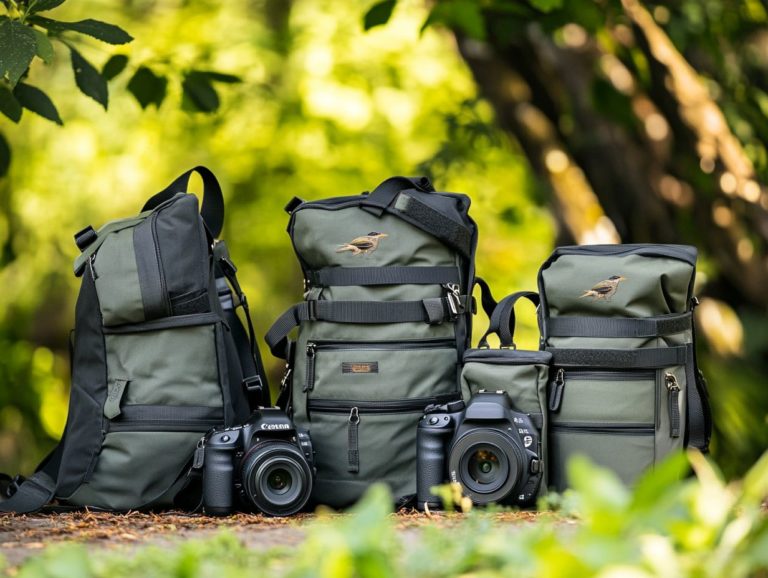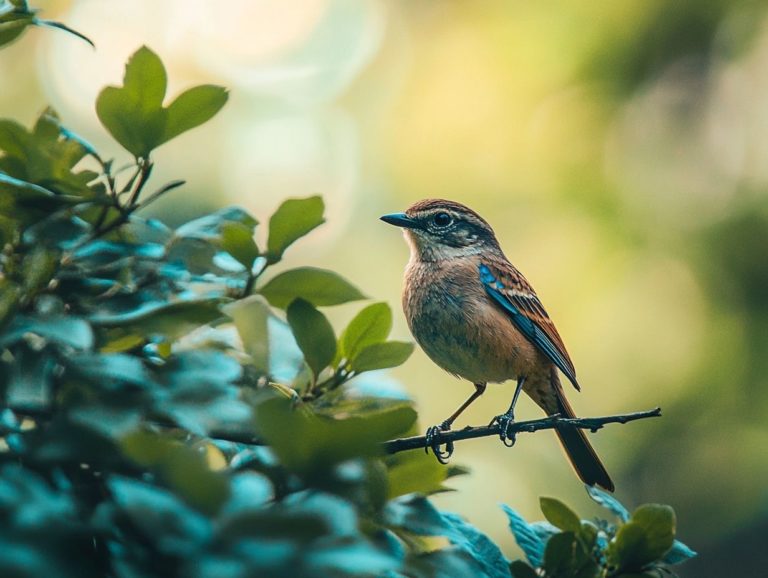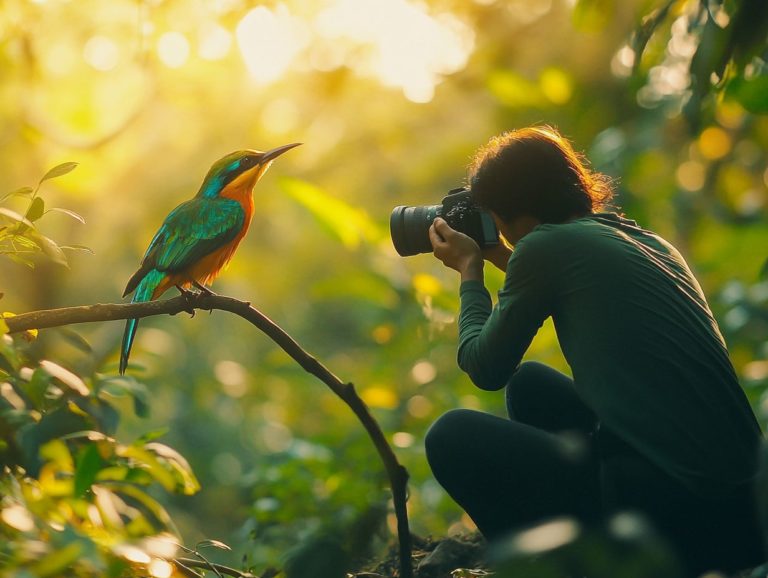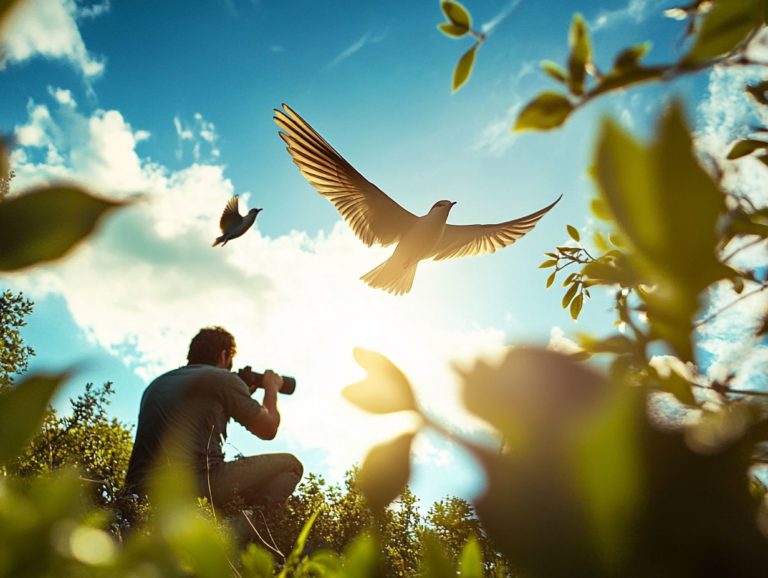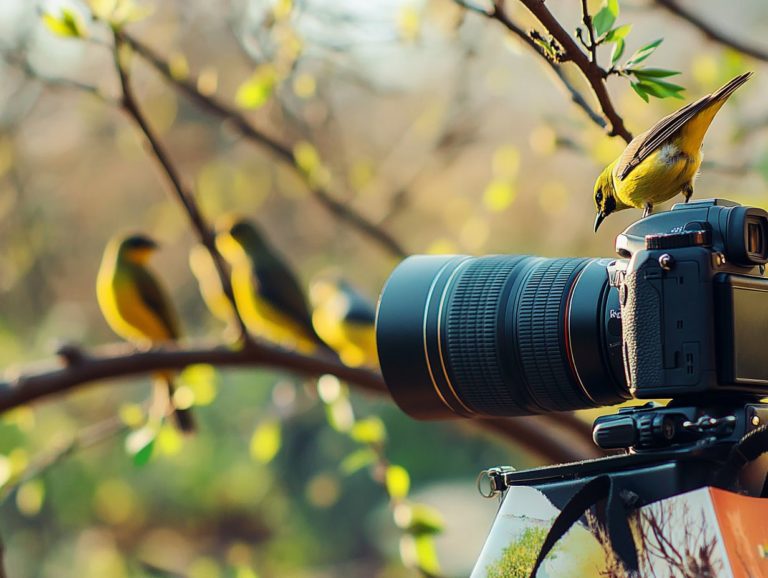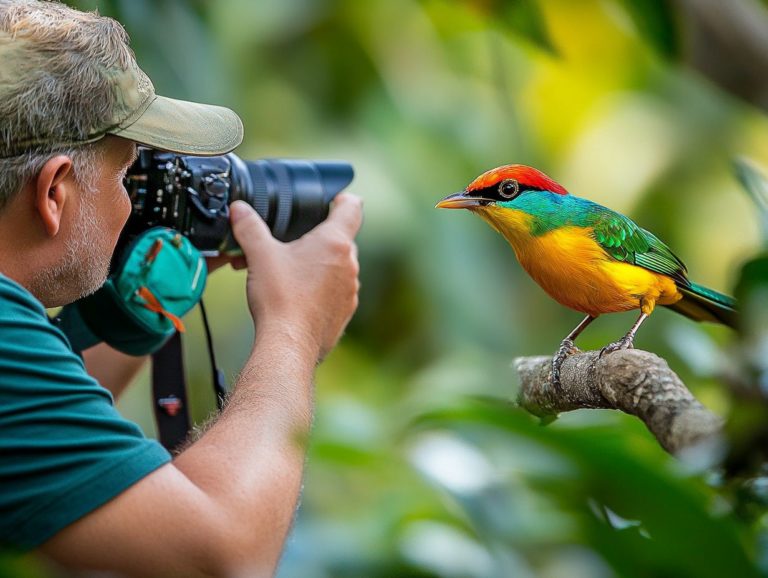5 Must-Have Accessories for Bird Photographers
Bird photography is a captivating pursuit that requires both skill and the right tools. Whether you re aiming to capture the vibrant hues of a parrot or the intricate details of a sparrow, having the right accessories can truly transform your experience.
This article delves into five essential accessories that will elevate your bird photography game. Discover how these tools not only enhance your shots but also improve stability and protect your gear, ensuring you re always primed for that perfect moment in nature.
Contents
- Key Takeaways:
- 1. Telephoto Lens
- 2. Tripod or Monopod
- 3. Bean Bag or Gimbal Head
- 4. Remote Shutter Release
- 5. Camera Rain Cover
- What Makes These Accessories Essential for Bird Photography?
- How Do These Accessories Improve Bird Photography?
- What Are the Different Types of Telephoto Lenses Available for Bird Photography?
- How Do Tripods and Monopods Help with Bird Photography?
- What Are the Advantages of Using a Bean Bag or Gimbal Head for Bird Photography?
- Why Is a Remote Shutter Release Important for Bird Photography?
- What Are the Different Types of Camera Rain Covers and Which One Is Best for Bird Photography?
- Frequently Asked Questions
- What are the 5 must-have accessories for bird photographers?
- Why is a telephoto lens essential for bird photography?
- How does a tripod help in bird photography?
- Why is a bird feeder important for bird photographers?
- What is the purpose of a remote shutter release in bird photography?
- Why is a bird identification guide necessary for bird photographers?
Key Takeaways:
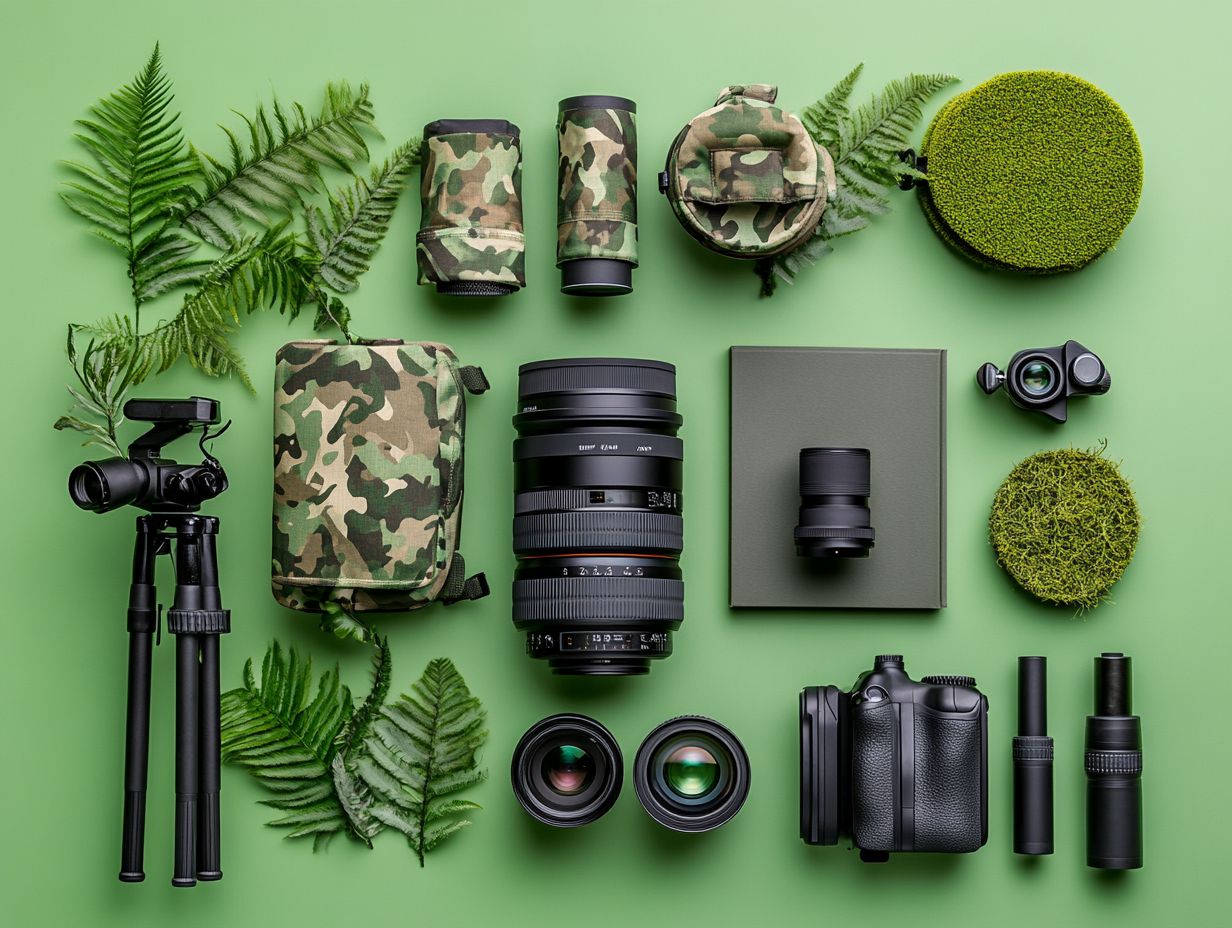
Invest in a telephoto lens for stunning close-up shots of birds.
A tripod or monopod improves stability and reduces shake for clear images.
Use a bean bag or gimbal head for a comfortable shooting base during long sessions.
1. Telephoto Lens
A telephoto lens is vital for wildlife photography. It allows you to capture breathtaking images of distant subjects with remarkable detail and clarity whether you re exploring the lush Amazon rainforest or soaking in the stunning landscapes of Africa or Australia.
This specialized lens elevates image quality and gives you the flexibility to photograph elusive animals without intruding on their natural habitat. You can choose from an exciting array of telephoto lenses like the Nikon Z9 and Canon EOS R5, tailored to your shooting style.
Models such as the Nikon 500mm f/5.6E PF ED VR and Canon RF 800mm f/11 IS STM excel at isolating wildlife while preserving exquisite detail. Incorporating macro lenses and filters can further enhance your photographic techniques, allowing you to capture close-ups of intricate textures and vibrant colors that showcase the raw beauty of nature.
The right telephoto lens turns your outing into an exciting adventure, helping you create images that resonate long after the moment has passed.
2. Tripod or Monopod
A tripod or monopod is your ultimate companion for capturing breathtaking shots! It offers the stability and support your camera craves, enabling you to capture sharp, clear images in dynamic outdoor environments where lighting can be a challenge.
When you re out in the field, a tripod helps you frame stunning landscapes and ensures high-quality images, especially in low-light conditions or during long exposure techniques. A monopod is great for quick movements, allowing you to adapt swiftly to unpredictable animal actions.
As you select the perfect model, consider travel-friendly features such as weight, collapsibility, and height. A lightweight carbon fiber tripod enhances portability, while a monopod with a comfortable grip ensures ease of use. Your choice will depend on your specific shooting conditions and personal preferences.
3. Bean Bag or Gimbal Head
Using a bean bag or gimbal head can significantly enhance your shooting experience. These tools provide a flexible and stable platform for your camera, especially when capturing fast-moving wildlife subjects.
When tracking animals in their natural habitat, the choice between a bean bag and a gimbal head is crucial. A bean bag is portable and quick to set up, making it an outstanding option for wildlife photographers who need to adapt rapidly to different environments.
A gimbal head allows smooth movement of the camera, which is particularly advantageous when using heavy telephoto lenses that can feel unwieldy.
Ultimately, your decision hinges on shooting conditions. Bean bags might be ideal for static setups, while gimbal heads shine in dynamic situations, offering greater control and responsiveness.
4. Remote Shutter Release
A remote shutter release is a critical accessory for your wildlife photography journey. It minimizes camera shake and allows you to capture fleeting, candid moments of wildlife without physically touching your camera. This significantly enhances the quality of your images.
This essential tool comes in various options, including wired and wireless models. Wired releases connect directly to your camera, offering a reliable and often budget-friendly choice. Wireless models grant you greater freedom of movement, making them perfect for situations where distance matters.
You can use these shutter releases to experiment with long exposures, which is a technique to capture light for a longer time. This creates a smooth effect in your images. They also minimize vibrations during macro photography or allow you to take self-portraits without the frantic dash back to the camera.
By choosing the right type of remote shutter release, you can tailor your approach to different environments and elevate your overall shooting experience.
5. Camera Rain Cover
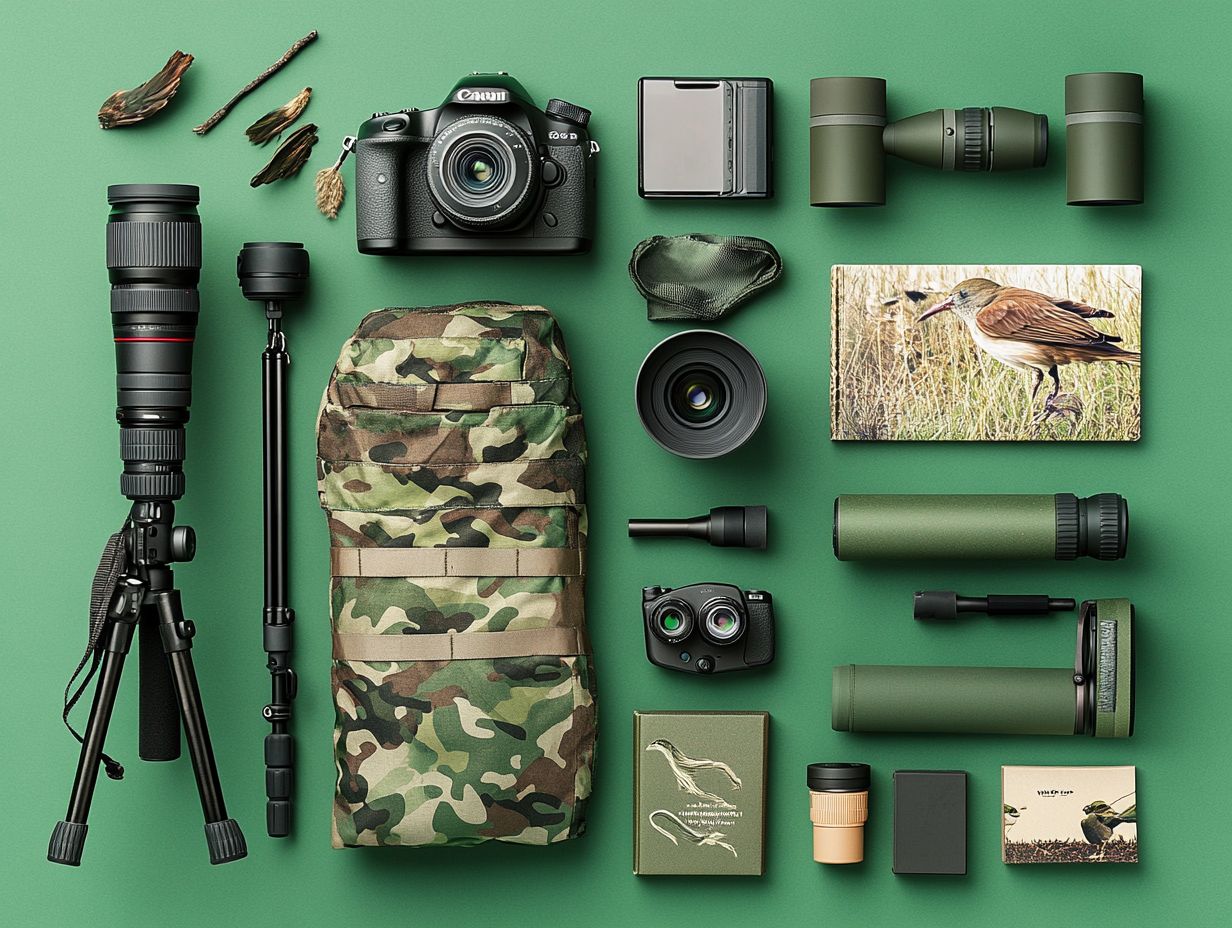
A camera rain cover is an essential item in your wildlife photography arsenal. It helps you capture breathtaking wildlife moments, even in bad weather!
The right rain cover can be the deciding factor between protecting your equipment and facing costly repairs. You ll find options like custom-fit covers, universal fit styles, and even DIY solutions.
Each has its advantages; for instance, custom-fit covers offer exceptional protection but can be expensive, while universal options balance affordability and adaptability.
When selecting the perfect rain cover, consider compatibility with your camera and lens, ease of use, and convenience for storage. Making the right choice boosts your performance and gives you the peace of mind you need while out in the field.
What Makes These Accessories Essential for Bird Photography?
The right accessories, such as a lens that lets you take close-up photos from a distance, a tripod, a remote shutter release, and a camera rain cover, are critical for bird photography. Additionally, consider checking out the top 5 essential accessories for bird watching. These tools empower you to capture stunning images of avian wildlife while expertly navigating various environmental challenges.
These accessories not only elevate the quality of your images but also provide essential stabilization, especially in tricky conditions like windy weather or low light. A sturdy tripod is your best friend for long exposure shots, especially during early mornings or in dense forests.
A remote shutter release is a game changer that minimizes camera shake when you press the shutter button. This means you get crisp, clean images.
Don t overlook the camera rain cover! It safeguards your precious gear from sudden weather changes, allowing you to focus on your subject rather than worrying about your equipment.
Together, these accessories improve your image quality and streamline your workflow, making your photography outings organized and effective.
Get these essential accessories and elevate your bird photography today!
How Do These Accessories Improve Bird Photography?
Bird photography becomes an exhilarating adventure with the right accessories! Specialized tools like telephoto lenses and tripods significantly enhance the quality of your images. To further elevate your experience, check out the 5 must-have apps for bird photographers, which give you the power to capture hard-to-get birds and fleeting moments with remarkable clarity and detail.
By integrating high-quality equipment into your workflow, you can achieve superior image stabilization, which means reducing blurriness caused by camera shake. This is particularly important when photographing birds in flight or at a distance, where every detail matters.
Choosing the right tripod not only provides the sturdiness you need but also facilitates smoother panning, making it easier to track fast-moving subjects. For optimal results, take the time to familiarize yourself with your tripod s height and rotation features, allowing you to quickly adjust to varying bird heights and angles.
Using teleconverters extends your focal lengths and keeps your setup compact. This lets you adapt easily to different environments and lighting conditions.
What Are the Different Types of Telephoto Lenses Available for Bird Photography?
In terms of bird photography, you have various telephoto lenses at your disposal, from budget-friendly options to high-end models like the Nikon Z9 and Canon EOS R5. To enhance your birdwatching experience, consider the photography gear essentials for birdwatching, as each of these lenses has unique features that cater to your specific shooting style and conditions.
Understanding the nuances of these lenses can profoundly influence your photography experience. For instance, prime lenses like the renowned 300mm f/2.8 are celebrated for their exceptional sharpness and ability to gather light, though they often come with a hefty price tag. On the other hand, zoom lenses such as the versatile 100-400mm grant you the flexibility to adjust your framing without the need to reposition yourself.
Ideal focal lengths, which determine how close or far you can capture your subject, can vary based on your needs. Longer lenses, such as 500mm or 600mm, allow you to capture close-up shots without disturbing the wildlife, while shorter lenses around 200mm might be more appropriate for broader scenes.
As you make your lens choice, be sure to consider weight, compatibility with your camera body, and stabilization features. These aspects can greatly improve your shooting experience across different environments.
How Do Tripods and Monopods Help with Bird Photography?
Tripods and monopods are essential tools in your bird photography arsenal, providing the stability and support your camera needs to capture crisp images of those swift-winged subjects. To enhance your setup, consider the best bird photography accessories for 2024, especially crucial in low-light conditions, where even the slightest camera shake can ruin a shot.
Each option has unique benefits based on your shooting style and environment. For example, when you’re patiently waiting for that elusive moment in a static location, like a birdwatching hide, a tripod is your best friend. It offers complete steadiness and allows for longer exposures, perfect for those serene shots.
On the other hand, if your photography involves more action like tracking birds in flight or weaving through thick foliage a monopod becomes invaluable. It grants you the mobility you need while still providing a measure of support.
Ultimately, your decision between a tripod and a monopod should reflect your preferences, the shot composition you envision, and the specific equipment in use. This way, you ensure that your chosen support complements your photographic vision seamlessly.
Choose the right accessories to elevate your bird photography experience today!
What Are the Advantages of Using a Bean Bag or Gimbal Head for Bird Photography?
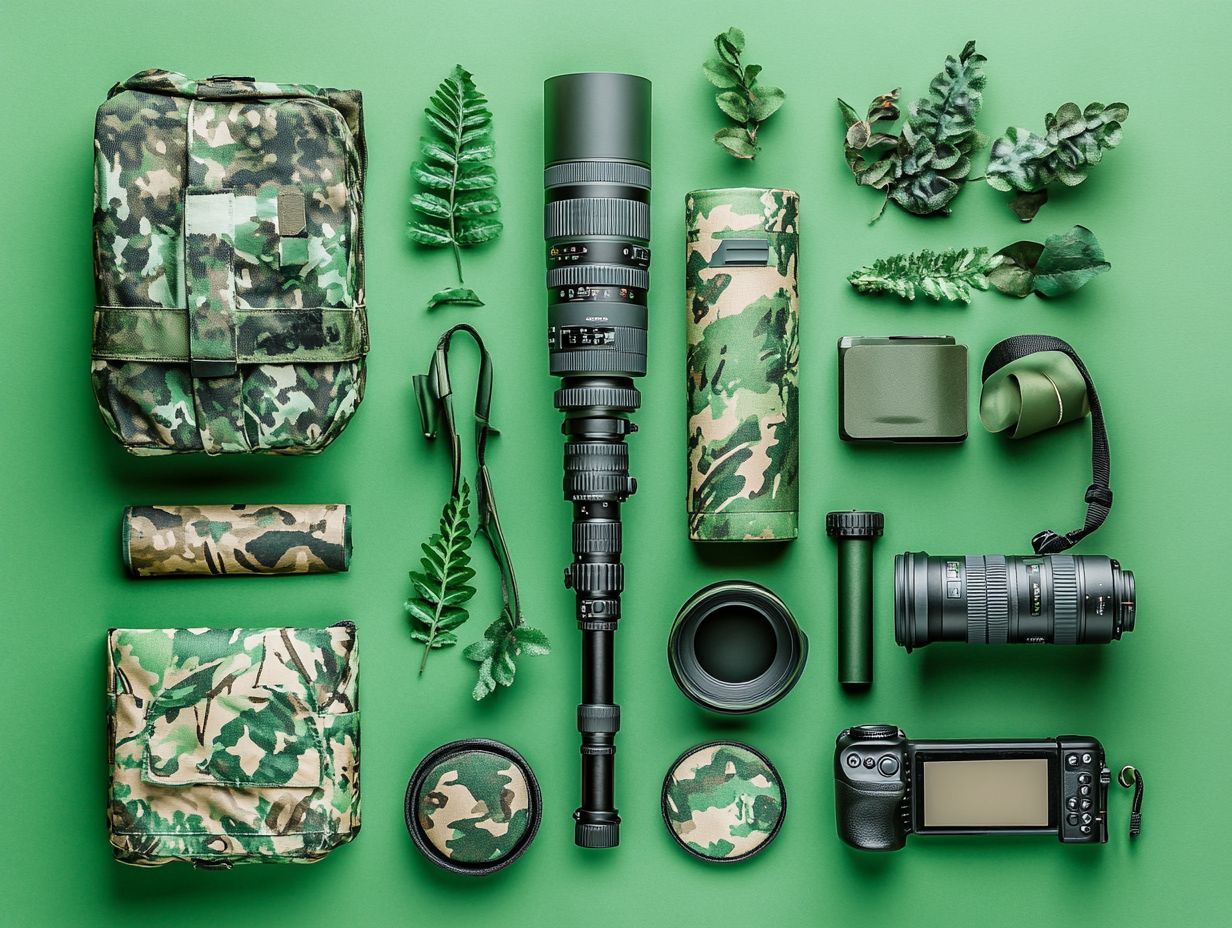
Using a bean bag or gimbal head can significantly elevate your bird photography game. These tools offer flexible support for your camera, allowing for quick adjustments and smooth tracking of moving subjects, which is crucial for capturing the active movements of birds. Additionally, consider the top 5 accessories for bird watching in winter to enhance your experience further.
This adaptability means you can seamlessly transition between different environments. Whether you re quietly perched in a hide or navigating a winding trail, a bean bag easily drapes over uneven surfaces. It provides stability while shooting from your car window or on rocky terrain, making it ideal for unexpected wildlife encounters.
On the flip side, gimbal heads really shine during fast-paced action. They stabilize your camera for smooth movement, making it easier to follow a hawk in flight or scan a flock of ducks in search of that perfect shot. Ultimately, these tools enhance the quality of your images and keep you agile to seize fleeting moments in the captivating world of avian life!
Why Is a Remote Shutter Release Important for Bird Photography?
A remote shutter release is essential for your bird photography endeavors. It allows you to capture stunning images without physically touching the camera, helping to eliminate camera shake and ensuring sharper photos of often timid birds in their natural habitats. Additionally, consider checking out the top 10 accessories for bird watchers you need to enhance your experience further.
You ll find this tool in various forms wired, wireless, and even smartphone-controlled options each offering unique benefits depending on your shooting scenario. For instance, during that magical dawn shoot, when birds are most active, a wireless remote lets you maintain a discreet distance. This avoids sudden movements that could send your subjects flying!
Conversely, a wired remote provides immediate precision when capturing perched birds without the potential interference from wireless signals.
By adapting to diverse environments, the right remote shutter release can elevate the quality of your images, allowing for breathtaking close-ups without disturbing the scene.
What Are the Different Types of Camera Rain Covers and Which One Is Best for Bird Photography?
You ll find several types of camera rain covers designed specifically to shield your photography equipment from moisture and rain. This is crucial for bird photography in unpredictable outdoor conditions.
From lightweight ponchos that are easy to carry to more robust, purpose-built covers, you can select one that meets the specific demands of your shoot. Materials like nylon and polyester provide varying levels of water resistance and breathability. Some covers even feature additional waterproof coatings for enhanced durability.
If you re working with larger lenses, opting for specialized, fitted rain covers is advisable. They offer superior protection while allowing for quick adjustments. When choosing the right cover, consider factors such as local weather conditions, your frequency of shooting in the rain, and the type of equipment you use.
This thoughtful approach ensures your gear stays safe while you capture breathtaking images of birds in their natural habitats.
Frequently Asked Questions
What are the 5 must-have accessories for bird photographers?
The 5 must-have accessories for bird photography are a telephoto lens, a tripod, a bird feeder, a remote shutter release, and a bird identification guide.
Why is a telephoto lens essential for bird photography?
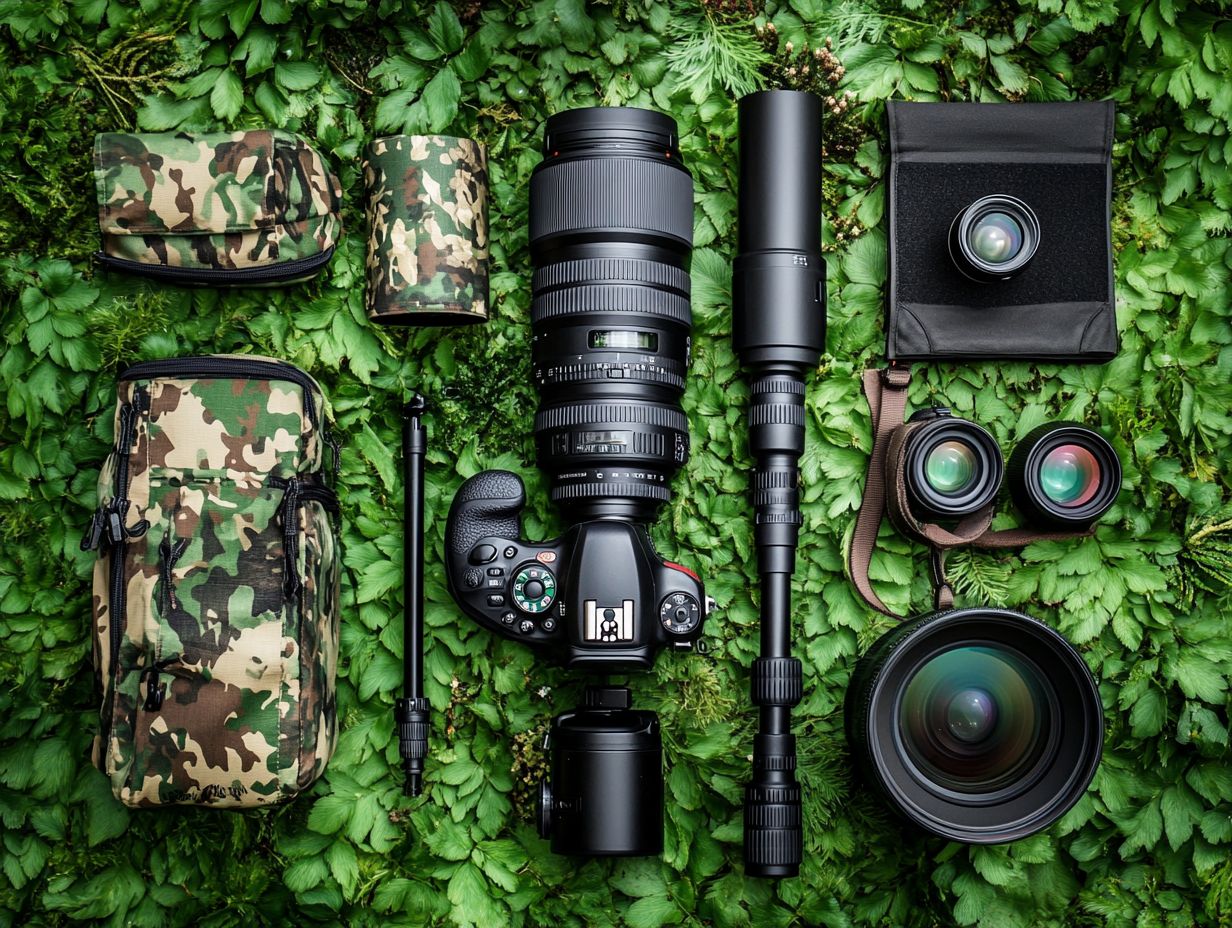
A telephoto lens is essential for bird photography because it allows you to get close-up shots of birds without disturbing their natural behavior and habitat. For more insights on this topic, check out the top 5 birdwatching photography gear reviews.
How does a tripod help in bird photography?
A tripod helps in bird photography by providing stability and reducing camera shake. This results in sharper and more focused images.
Why is a bird feeder important for bird photographers?
A bird feeder attracts birds to a specific area, making it easier to capture them in their natural environment.
What is the purpose of a remote shutter release in bird photography?
Capture stunning bird photos effortlessly! A remote shutter release is a device that lets you take pictures without touching the camera.
This reduces the risk of scaring away birds and ensures a steady shot.
Why is a bird identification guide necessary for bird photographers?
Bird photographers need a bird identification guide. It helps them discover amazing species and behaviors for breathtaking shots.

